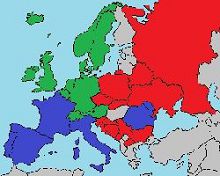
Gabriel — an acronym for “Gateway and Bridge to Europe’s National Libraries” — was launched in January 1997 as a common portal giving access to the internet services of the participating libraries.
As stated on its website: “Gabriel also recalls Gabriel Naudé, whose ‘Advis pour dresser une bibliothèque’ (Paris, 1627) is one of the earliest theoretical works about libraries in any European language and provides a blueprint for the great modern research library. The name Gabriel is common to many European languages and is derived from the Old Testament, where Gabriel appears as one of the archangels or heavenly messengers. He also appears in a similar role in the New Testament and the Qu’ran.”
In 1998, Gabriel offered links to the internet services of 38 participating national libraries (Albania, Austria, Belgium, Bulgaria, Croatia, Czech Republic, Denmark, Estonia, Finland, France, Germany, Greece, Hungary, Iceland, Ireland, Italy, Latvia, Liechtenstein, Lithuania, Luxembourg, Macedonia, Malta, Netherlands, Norway, Poland, Portugal, Romania, Russia, San Marino, Slovakia, Slovenia, Spain, Sweden, Switzerland, Turkey, United Kingdom, Vatican City). These links led to OPACs (Open Public Access Catalogs), national bibliographies, national union catalogs, indexes for periodicals, web servers and gophers, with a section for common European projects.
How did Gabriel begin? During the 1994 CENL annual meeting in Oslo, Norway, it was suggested that national libraries should set up a common electronic board with updates about their ongoing internet projects.
Representatives from the national libraries in the Netherlands (Koninklijke Bibliotheek), United Kingdom (British Library) and Finland (Helsinki University Library) met in March 1995 in The Hague, Netherlands, to launch the pilot Gabriel project. They were joined then by the national libraries in Germany (Deutsche Bibliothek), France (Bibliothèque Nationale de France) and Poland (Biblioteka Narodowa). Gabriel would describe their services and collections, while seeking to attract other national libraries into the project.
The original Gabriel website was launched in September 1995. It was maintained by the British Library Network Services and mirrored on the servers of the national libraries in the Netherlands and Finland. In November 1995, other national libraries were invited to submit entries describing their services and collections, after they launched their own websites and online catalogs. The number of participating libraries expanded.
During the 1996 CENL annual meeting in Lisbon, Portugal, it was decided that Gabriel would become an official CENL website in January 1997.
The new trilingual (English, French, German) Gabriel portal was maintained by the national library in the Netherlands (Koninklijke Bibliotheek), and mirrored on the servers of four other national libraries, in United Kingdom, Finland, Germany and Slovenia.
What about public libraries? According to “Internet and the Library Sphere”, a document available on the website of the European Commission, 1,000 public libraries from 26 European countries had their own websites in December 1998. The websites ranged from one webpage with a postal address and opening hours to a full website with access to the library’s OPAC.
The leading countries were Finland (247 libraries), Sweden (132 libraries), United Kingdom (112 libraries), Denmark (107 libraries), Germany (102 libraries), Netherlands (72 libraries), Lithuania (51 libraries), Spain (56 libraries) and Norway (45 libraries). Russia had a common website for 26 public reference libraries. Newcomers were the Czech Republic (29 libraries) and Portugal (3 libraries).
As for Gabriel’s fate, the portal merged in summer 2005 with the European Library’s website (created by CENL in January 2004) to offer a common portal for the 43 European national libraries. Europeana, the European digital library, was launched three years later, in November 2008, with two million documents. Europeana offered 6 million documents in March 2010, and 10 million documents on a revamped website in September 2010.
Copyright © 2011 Marie Lebert
ToC :: Next article: eBooks: 1997 – The Electronic Beowulf Project